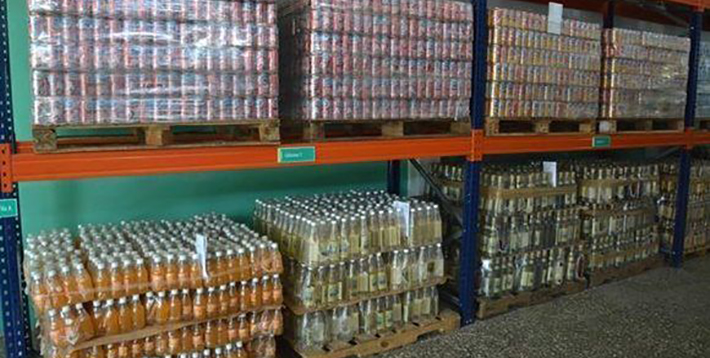
The ‘ephemeral’ wholesale market, cooperatives and self-employment
HAVANA – On Friday, March 16, it was reported that the first food wholesale market for the non-state sector was opened specifically for cooperatives that manage restaurants that previously belonged to state-owned companies.
It was reported that conditions permitting, this possibility would be extended to self-employed workers who rent state properties. They are limited to Havana, although it will be offered in other provinces when the situation is shown to work.
This market (Mercabal) located in the municipality of Plaza will discount 20% from the retail price of a selected group of products in high demand. These include beverages, cigars, beans, sugar, salt, hamburgers and chicken; for the latter the price will be discounted by 30%. A good part of the products offered are imported goods. This new initiative, in the absence of a prudential timeline to evaluate its results, leaves several issues of capital importance unanswered, while at the same time introducing additional complexities in economic management.
Prices suffer several distortions in Cuba. Both the current monetary-exchange system, central planning, and the distortions exhibited by the relationships between economic agents are factors that help explain them. Any transformation that aspires to propitiate the development of the productive forces should move in the direction of reducing these distortions, and reward the most efficient producers. Paragraph 50 of the Conceptualization states: “The sustainability of socialism is associated with development, and requires rhythms and structures of economic growth that ensure prosperity with social justice …”
Mercabal will accept a small group of customers who are participants in gastronomic activities, and there are few signs that it extends any advantage to the most efficient producers, most of whom will not be represented among the “selected” ones.
In this same manner a parallel system is created to the existing wholesale trade in two fundamental areas. On the one hand, there are already companies that fulfill this function. These could have been made responsible for doing this — an option that was foreseen in the 2016 resolutions, but that left clients unsatisfied due to the high prices and insufficient quality, and the shortage of products. The same companies use prices for the public sector, while selling the same product at another price for the non-state sector (which they are actually a part of). With this, instead of reducing price differences, they are increased.
Written in paragraph 239 of the Conceptualization is the following: “Wholesale prices and retailers are formed in consideration of the internal and external markets. They configure a coherently interconnected integral system, so that they fulfill the function of measuring economic facts, and stimulate efficiency.”
Another questionable point is the criterion to determine access to this “advantage,” which has little to do with leveling the playing field to incentivize efficiency gains. What it does help is to clear the current interpretation that private enterprise (barely mentioned, although it is enshrined in long-discussed documents) and the self-employed will be subsidiary forms of the state company. Differentiation on the basis of the form of ownership is not what is desired, insofar as it is an essentially political argument.
With this procedure, it has been announced that the condition of “subsidiarity” does not only have to do with the type of sector, but also with the type of property per se. Within the same industry, different types of companies may coexist whose access to products and other materials will be a reflection of their place in the priority scale of public policy, which apparently will move down from the state enterprise, to cooperatives and private companies. In addition to being a failed formula that has already been used in Cuba and in many other contexts, it represents an insurmountable contradiction to the stated objective of improving economic performance through, among other means, the increase in economic efficiency.
Paragraph 246 reads: “Providing producers of different forms of ownership and management with similar conditions of access to markets …” If these are the stated goals, this change takes us away from them. And now we also know that “similar” does not mean under equal conditions.
On the other hand, it does not seem to make a substantial contribution in alleviating the pressure sought by those who visit these establishments and who buy from the retail network. Given the current low import capacity and the low output of domestic producers, elements that limit the increase in supply, the total quantities available should therefore not vary significantly.
Consumers will continue to compete with these establishments, only now they will not be so aware of it. The amount that goes to each destination is decided elsewhere in the chain. In addition, given that the number of beneficiaries is a smaller part of the universe of competitors, the competition among the rest of the private entities will remain.
It is almost certain that there will be very good reasons and many ‘better intentions’ mentioned as reasons for the measure, but it has every ingredient necessary to make it look like a last-minute attempt to re-float the idea of many non-agricultural cooperatives that come from state companies, after repeating ad nauseam that they are an alternative compatible with socialism, because of its social nature.
Despite of it all, this form of management did not fare well in the latest changes announced as part of the “new policy towards self-employment and the non-agricultural cooperatives.” External limits to the differentials of payments between partners were announced and they will not be able to sell goods or services outside the territory where they have legal residence. It’s a give and take …
At the end of the day, it’s been explained as an “experiment,” subject to change. Everything is so ephemeral …
Photo at top from Cubadebate.


